- Dutch
- Frisian
- Saterfrisian
- Afrikaans
-
- Phonology
- Segment inventory
- Phonotactics
- Phonological processes
- Phonology-morphology interface
- Word stress
- Primary stress in simplex words
- Monomorphemic words
- Diachronic aspects
- Generalizations on stress placement
- Default penultimate stress
- Lexical stress
- The closed penult restriction
- Final closed syllables
- The diphthong restriction
- Superheavy syllables (SHS)
- The three-syllable window
- Segmental restrictions
- Phonetic correlates
- Stress shifts in loanwords
- Quantity-sensitivity
- Secondary stress
- Vowel reduction in unstressed syllables
- Stress in complex words
- Primary stress in simplex words
- Accent & intonation
- Clitics
- Spelling
- Morphology
- Word formation
- Compounding
- Nominal compounds
- Verbal compounds
- Adjectival compounds
- Affixoids
- Coordinative compounds
- Synthetic compounds
- Reduplicative compounds
- Phrase-based compounds
- Elative compounds
- Exocentric compounds
- Linking elements
- Separable complex verbs (SCVs)
- Gapping of complex words
- Particle verbs
- Copulative compounds
- Derivation
- Numerals
- Derivation: inputs and input restrictions
- The meaning of affixes
- Non-native morphology
- Cohering and non-cohering affixes
- Prefixation
- Suffixation
- Nominal suffixation: person nouns
- Conversion
- Pseudo-participles
- Bound forms
- Nouns
- Nominal prefixes
- Nominal suffixes
- -aal and -eel
- -aar
- -aard
- -aat
- -air
- -aris
- -ast
- Diminutives
- -dom
- -een
- -ees
- -el (nominal)
- -elaar
- -enis
- -er (nominal)
- -erd
- -erik
- -es
- -eur
- -euse
- ge...te
- -heid
- -iaan, -aan
- -ief
- -iek
- -ier
- -ier (French)
- -ière
- -iet
- -igheid
- -ij and allomorphs
- -ijn
- -in
- -ing
- -isme
- -ist
- -iteit
- -ling
- -oir
- -oot
- -rice
- -schap
- -schap (de)
- -schap (het)
- -sel
- -st
- -ster
- -t
- -tal
- -te
- -voud
- Verbs
- Adjectives
- Adverbs
- Univerbation
- Neo-classical word formation
- Construction-dependent morphology
- Morphological productivity
- Compounding
- Inflection
- Inflection and derivation
- Allomorphy
- The interface between phonology and morphology
- Word formation
- Syntax
- Preface and acknowledgements
- Verbs and Verb Phrases
- 1 Characterization and classification
- 2 Projection of verb phrases I:Argument structure
- 3 Projection of verb phrases II:Verb frame alternations
- Introduction
- 3.1. Main types
- 3.2. Alternations involving the external argument
- 3.3. Alternations of noun phrases and PPs
- 3.3.1. Dative/PP alternations (dative shift)
- 3.3.1.1. Dative alternation with aan-phrases (recipients)
- 3.3.1.2. Dative alternation with naar-phrases (goals)
- 3.3.1.3. Dative alternation with van-phrases (sources)
- 3.3.1.4. Dative alternation with bij-phrases (possessors)
- 3.3.1.5. Dative alternation with voor-phrases (benefactives)
- 3.3.1.6. Conclusion
- 3.3.1.7. Bibliographical notes
- 3.3.2. Accusative/PP alternations
- 3.3.3. Nominative/PP alternations
- 3.3.1. Dative/PP alternations (dative shift)
- 3.4. Some apparent cases of verb frame alternation
- 3.5. Bibliographical notes
- 4 Projection of verb phrases IIIa:Selection of clauses/verb phrases
- 5 Projection of verb phrases IIIb:Argument and complementive clauses
- Introduction
- 5.1. Finite argument clauses
- 5.2. Infinitival argument clauses
- 5.3. Complementive clauses
- 6 Projection of verb phrases IIIc:Complements of non-main verbs
- 7 Projection of verb phrases IIId:Verb clusters
- 8 Projection of verb phrases IV: Adverbial modification
- 9 Word order in the clause I:General introduction
- 10 Word order in the clause II:Position of the finite verb (verb-first/second)
- 11 Word order in the clause III:Clause-initial position (wh-movement)
- Introduction
- 11.1. The formation of V1- and V2-clauses
- 11.2. Clause-initial position remains (phonetically) empty
- 11.3. Clause-initial position is filled
- 12 Word order in the clause IV:Postverbal field (extraposition)
- 13 Word order in the clause V: Middle field (scrambling)
- 14 Main-clause external elements
- Nouns and Noun Phrases
- 1 Characterization and classification
- 2 Projection of noun phrases I: complementation
- Introduction
- 2.1. General observations
- 2.2. Prepositional and nominal complements
- 2.3. Clausal complements
- 2.4. Bibliographical notes
- 3 Projection of noun phrases II: modification
- Introduction
- 3.1. Restrictive and non-restrictive modifiers
- 3.2. Premodification
- 3.3. Postmodification
- 3.3.1. Adpositional phrases
- 3.3.2. Relative clauses
- 3.3.3. Infinitival clauses
- 3.3.4. A special case: clauses referring to a proposition
- 3.3.5. Adjectival phrases
- 3.3.6. Adverbial postmodification
- 3.4. Bibliographical notes
- 4 Projection of noun phrases III: binominal constructions
- Introduction
- 4.1. Binominal constructions without a preposition
- 4.2. Binominal constructions with a preposition
- 4.3. Bibliographical notes
- 5 Determiners: articles and pronouns
- Introduction
- 5.1. Articles
- 5.2. Pronouns
- 5.3. Bibliographical notes
- 6 Numerals and quantifiers
- 7 Pre-determiners
- Introduction
- 7.1. The universal quantifier al 'all' and its alternants
- 7.2. The pre-determiner heel 'all/whole'
- 7.3. A note on focus particles
- 7.4. Bibliographical notes
- 8 Syntactic uses of noun phrases
- Adjectives and Adjective Phrases
- 1 Characteristics and classification
- 2 Projection of adjective phrases I: Complementation
- 3 Projection of adjective phrases II: Modification
- 4 Projection of adjective phrases III: Comparison
- 5 Attributive use of the adjective phrase
- 6 Predicative use of the adjective phrase
- 7 The partitive genitive construction
- 8 Adverbial use of the adjective phrase
- 9 Participles and infinitives: their adjectival use
- 10 Special constructions
- Adpositions and adpositional phrases
- 1 Characteristics and classification
- Introduction
- 1.1. Characterization of the category adposition
- 1.2. A formal classification of adpositional phrases
- 1.3. A semantic classification of adpositional phrases
- 1.3.1. Spatial adpositions
- 1.3.2. Temporal adpositions
- 1.3.3. Non-spatial/temporal prepositions
- 1.4. Borderline cases
- 1.5. Bibliographical notes
- 2 Projection of adpositional phrases: Complementation
- 3 Projection of adpositional phrases: Modification
- 4 Syntactic uses of the adpositional phrase
- 5 R-pronominalization and R-words
- 1 Characteristics and classification
- Phonology
-
- General
- Phonology
- Segment inventory
- Phonotactics
- Phonological Processes
- Assimilation
- Vowel nasalization
- Syllabic sonorants
- Final devoicing
- Fake geminates
- Vowel hiatus resolution
- Vowel reduction introduction
- Schwa deletion
- Schwa insertion
- /r/-deletion
- d-insertion
- {s/z}-insertion
- t-deletion
- Intrusive stop formation
- Breaking
- Vowel shortening
- h-deletion
- Replacement of the glide w
- Word stress
- Clitics
- Allomorphy
- Orthography of Frisian
- Morphology
- Inflection
- Word formation
- Derivation
- Prefixation
- Infixation
- Suffixation
- Nominal suffixes
- Verbal suffixes
- Adjectival suffixes
- Adverbial suffixes
- Numeral suffixes
- Interjectional suffixes
- Onomastic suffixes
- Conversion
- Compositions
- Derivation
- Syntax
- Verbs and Verb Phrases
- Characteristics and classification
- Unergative and unaccusative subjects
- Evidentiality
- To-infinitival clauses
- Predication and noun incorporation
- Ellipsis
- Imperativus-pro-Infinitivo
- Expression of irrealis
- Embedded Verb Second
- Agreement
- Negation
- Nouns & Noun Phrases
- Classification
- Complementation
- Modification
- Partitive noun constructions
- Referential partitive constructions
- Partitive measure nouns
- Numeral partitive constructions
- Partitive question constructions
- Nominalised quantifiers
- Kind partitives
- Partitive predication with prepositions
- Bare nominal attributions
- Articles and names
- Pronouns
- Quantifiers and (pre)determiners
- Interrogative pronouns
- R-pronouns
- Syntactic uses
- Adjective Phrases
- Characteristics and classification
- Complementation
- Modification and degree quantification
- Comparison by degree
- Comparative
- Superlative
- Equative
- Attribution
- Agreement
- Attributive adjectives vs. prenominal elements
- Complex adjectives
- Noun ellipsis
- Co-occurring adjectives
- Predication
- Partitive adjective constructions
- Adverbial use
- Participles and infinitives
- Adposition Phrases
- Characteristics and classification
- Complementation
- Modification
- Intransitive adpositions
- Predication
- Preposition stranding
- Verbs and Verb Phrases
-
- General
- Morphology
- Morphology
- 1 Word formation
- 1.1 Compounding
- 1.1.1 Compounds and their heads
- 1.1.2 Special types of compounds
- 1.1.2.1 Affixoids
- 1.1.2.2 Coordinative compounds
- 1.1.2.3 Synthetic compounds and complex pseudo-participles
- 1.1.2.4 Reduplicative compounds
- 1.1.2.5 Phrase-based compounds
- 1.1.2.6 Elative compounds
- 1.1.2.7 Exocentric compounds
- 1.1.2.8 Linking elements
- 1.1.2.9 Separable Complex Verbs and Particle Verbs
- 1.1.2.10 Noun Incorporation Verbs
- 1.1.2.11 Gapping
- 1.2 Derivation
- 1.3 Minor patterns of word formation
- 1.1 Compounding
- 2 Inflection
- 1 Word formation
- Morphology
- Syntax
- Adjectives and adjective phrases (APs)
- 0 Introduction to the AP
- 1 Characteristics and classification of APs
- 2 Complementation of APs
- 3 Modification and degree quantification of APs
- 4 Comparison by comparative, superlative and equative
- 5 Attribution of APs
- 6 Predication of APs
- 7 The partitive adjective construction
- 8 Adverbial use of APs
- 9 Participles and infinitives as APs
- Nouns and Noun Phrases (NPs)
- 0 Introduction to the NP
- 1 Characteristics and Classification of NPs
- 2 Complementation of NPs
- 3 Modification of NPs
- 3.1 Modification of NP by Determiners and APs
- 3.2 Modification of NP by PP
- 3.3 Modification of NP by adverbial clauses
- 3.4 Modification of NP by possessors
- 3.5 Modification of NP by relative clauses
- 3.6 Modification of NP in a cleft construction
- 3.7 Free relative clauses and selected interrogative clauses
- 4 Partitive noun constructions and constructions related to them
- 4.1 The referential partitive construction
- 4.2 The partitive construction of abstract quantity
- 4.3 The numerical partitive construction
- 4.4 The partitive interrogative construction
- 4.5 Adjectival, nominal and nominalised partitive quantifiers
- 4.6 Kind partitives
- 4.7 Partitive predication with a preposition
- 4.8 Bare nominal attribution
- 5 Articles and names
- 6 Pronouns
- 7 Quantifiers, determiners and predeterminers
- 8 Interrogative pronouns
- 9 R-pronouns and the indefinite expletive
- 10 Syntactic functions of Noun Phrases
- Adpositions and Adpositional Phrases (PPs)
- 0 Introduction to the PP
- 1 Characteristics and classification of PPs
- 2 Complementation of PPs
- 3 Modification of PPs
- 4 Bare (intransitive) adpositions
- 5 Predication of PPs
- 6 Form and distribution of adpositions with respect to staticity and construction type
- 7 Adpositional complements and adverbials
- Verbs and Verb Phrases (VPs)
- 0 Introduction to the VP in Saterland Frisian
- 1 Characteristics and classification of verbs
- 2 Unergative and unaccusative subjects and the auxiliary of the perfect
- 3 Evidentiality in relation to perception and epistemicity
- 4 Types of to-infinitival constituents
- 5 Predication
- 5.1 The auxiliary of being and its selection restrictions
- 5.2 The auxiliary of going and its selection restrictions
- 5.3 The auxiliary of continuation and its selection restrictions
- 5.4 The auxiliary of coming and its selection restrictions
- 5.5 Modal auxiliaries and their selection restrictions
- 5.6 Auxiliaries of body posture and aspect and their selection restrictions
- 5.7 Transitive verbs of predication
- 5.8 The auxiliary of doing used as a semantically empty finite auxiliary
- 5.9 Supplementive predication
- 6 The verbal paradigm, irregularity and suppletion
- 7 Verb Second and the word order in main and embedded clauses
- 8 Various aspects of clause structure
- Adjectives and adjective phrases (APs)
-
- General
- Phonology
- Afrikaans phonology
- Segment inventory
- Overview of Afrikaans vowels
- The diphthongised long vowels /e/, /ø/ and /o/
- The unrounded mid-front vowel /ɛ/
- The unrounded low-central vowel /ɑ/
- The unrounded low-central vowel /a/
- The rounded mid-high back vowel /ɔ/
- The rounded high back vowel /u/
- The rounded and unrounded high front vowels /i/ and /y/
- The unrounded and rounded central vowels /ə/ and /œ/
- The diphthongs /əi/, /œy/ and /œu/
- Overview of Afrikaans consonants
- The bilabial plosives /p/ and /b/
- The alveolar plosives /t/ and /d/
- The velar plosives /k/ and /g/
- The bilabial nasal /m/
- The alveolar nasal /n/
- The velar nasal /ŋ/
- The trill /r/
- The lateral liquid /l/
- The alveolar fricative /s/
- The velar fricative /x/
- The labiodental fricatives /f/ and /v/
- The approximants /ɦ/, /j/ and /ʋ/
- Overview of Afrikaans vowels
- Word stress
- The phonetic properties of stress
- Primary stress on monomorphemic words in Afrikaans
- Background to primary stress in monomorphemes in Afrikaans
- Overview of the Main Stress Rule of Afrikaans
- The short vowels of Afrikaans
- Long vowels in monomorphemes
- Primary stress on diphthongs in monomorphemes
- Exceptions
- Stress shifts in place names
- Stress shift towards word-final position
- Stress pattern of reduplications
- Phonological processes
- Vowel related processes
- Consonant related processes
- Homorganic glide insertion
- Phonology-morphology interface
- Phonotactics
- Morphology
- Syntax
- Afrikaans syntax
- Nouns and noun phrases
- Characteristics of the NP
- Classification of nouns
- Complementation of NPs
- Modification of NPs
- Binominal and partitive constructions
- Referential partitive constructions
- Partitive measure nouns
- Numeral partitive constructions
- Partitive question constructions
- Partitive constructions with nominalised quantifiers
- Partitive predication with prepositions
- Binominal name constructions
- Binominal genitive constructions
- Bare nominal attribution
- Articles and names
- Pronouns
- Quantifiers, determiners and predeterminers
- Syntactic uses of the noun phrase
- Adjectives and adjective phrases
- Characteristics and classification of the AP
- Complementation of APs
- Modification and Degree Quantification of APs
- Comparison by comparative, superlative and equative degree
- Attribution of APs
- Predication of APs
- The partitive adjective construction
- Adverbial use of APs
- Participles and infinitives as adjectives
- Verbs and verb phrases
- Characterisation and classification
- Argument structure
- Verb frame alternations
- Complements of non-main verbs
- Verb clusters
- Complement clauses
- Adverbial modification
- Word order in the clause: Introduction
- Word order in the clause: position of the finite Verb
- Word order in the clause: Clause-initial position
- Word order in the clause: Extraposition and right-dislocation in the postverbal field
- Word order in the middle field
- Emphatic constructions
- Adpositions and adposition phrases
This section discusses the meaning contribution of spatio-temporal adverbial phrases in more detail. The basic observation is that clauses may contain more than one temporal or locational adverbial, as illustrated in the sentences in (109): the adverbials preceding the modal adverb (gisteren/in Amsterdam) function as clause adverbials while the ones following the modal (om drie uur/bij zijn tante) function as VP adverbials.
| a. | Jan is gisteren | waarschijnlijk | om drie uur | vertrokken. | |
| Jan is yesterday | probably | at 3 oʼclock | left | ||
| 'Jan probably left at 3 oʼclock yesterday.' | |||||
| b. | Jan heeft | in Amsterdam | waarschijnlijk | bij zijn tante | gelogeerd. | |
| Jan has | in Amsterdam | probably | with his aunt | stayed | ||
| 'Jan has probably stayed with his aunt in Amsterdam.' | ||||||
This raises the question in what way the meaning contributions of these clause and VP adverbials differ. Our point of departure in answering this question will be binary tense theory: cf. Te Winkel (1866) and Verkuyl (2008). This theory was introduced in Section 1.5.1 and used in the description of the Dutch Tense system in Section 1.5.4. Although we will assume that the reader is familiar with these sections, we start in Subsection I by repeating some of the core findings, subsection II subsequently discusses the semantic contribution of the two kinds of temporal adverbials: we will argue that VP adverbials are modifiers of eventualities, while clause adverbials modify the temporal domains that contain them, subsection III will extend this proposal to locational adverbials.
Binary tense theory claims that the mental representation of tense is based on the three binary distinctions in (110). Languages differ when it comes to the means used for expressing these oppositions: this can be done within the verbal system by means of inflection and/or auxiliaries but it may also involve the use of adverbial phrases, aspectual markers, pragmatic information, etc.
| a. | ±past: present versus past |
| b. | ±posterior: future versus non-future |
| c. | ±perfect: imperfect versus perfect |
Verkuyl (2008) claims that Dutch expresses all the oppositions in (110) in the verbal system: +past is expressed by inflection, +posterior by the verb zullen'will', and +perfect by the auxiliaries hebben'to have' and zijn'to be'. This leads to the eight-way distinction between tenses in Table 1 found in most Dutch grammars.
| present | past | ||
| synchronous | imperfect | present Ik wandel. I walk | simple past Ik wandelde. I walked |
| perfect | present perfect Ik heb gewandeld. I have walked | past perfect Ik had gewandeld. I had walked | |
| posterior | imperfect | future Ik zal wandelen. I will walk | future in the past Ik zou wandelen. I would walk |
| perfect | future perfect Ik zal hebben gewandeld. I will have walked | future perfect in the past Ik zou hebben gewandeld. I would have walked | |
Sections 1.5.2 and 1.5.4 departed from Verkuyl’s original claim that zullen can be used as a future auxiliary and argued that it is an epistemic modal verb in all its uses—it is only due to pragmatic considerations that examples with zullen are sometimes interpreted with future time reference; cf. Broekhuis & Verkuyl (2014). If this is indeed correct, the Dutch verbal system only expresses the binary features ±past and ±perfect, and therefore does not make an eight-way but only a four-way tense distinction. This means that the traditional view on the Dutch verbal tense system in Table 1 should be replaced by the one in Table 2. Since the examples with zullen no longer define a separate set of future tenses, posteriority must be expressed by other means.
| present | past | |
| imperfect | simple present Ik wandel/Ik zal wandelen. I walk/I will walk | simple past Ik wandelde/Ik zou wandelen. I walked/I would walk |
| perfect | present perfect Ik heb gewandeld/ Ik zal hebben gewandeld. I have walked/I will have walked | past perfect Ik had gewandeld/ Ik zou hebben gewandeld. I had walked/I would have walked |
The revised view on the verbal tense system of Dutch implies that utterances in the simple present/past should in principle be able to refer to any subinterval within present/past-tense interval i . This is indicated in Figure 1, in which the dotted line indicates the time line, for various possible worlds in which simple present/past sentences like Ik wandel'I walk' and Ik wandelde'I walked' are predicted to be true; observe that the number of possible worlds is in principle infinite and that we simply made a selection that suits our purpose. World 1 depicts the situation in which eventuality k precedes speech time n or virtual speech-time-in-the-past n ', that is, the situation in which k is located in the actualized part ia of present/past-tense interval i. World 3 depicts the situation in which k follows n/n ', that is, in which it is located in the non-actualized part i◊ of present/past-tense interval i. World 2, finally, depicts the situation in which k occurs at n/n '. We did not mention time interval j yet, but its function will become clear shortly.
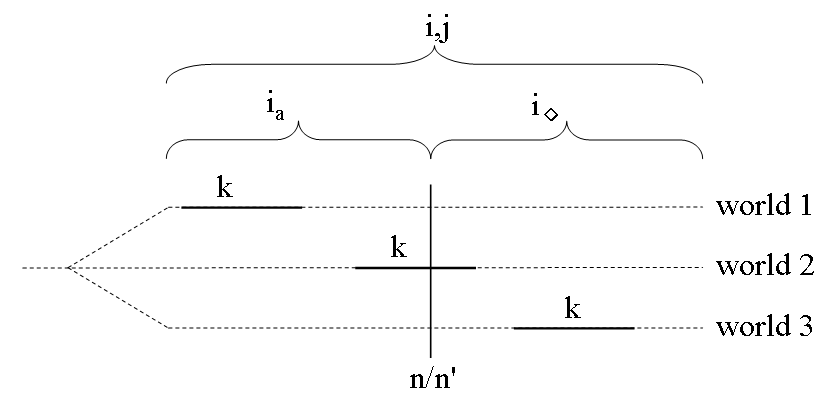
The representation of perfect tense examples like Ik heb gewandeld'I have walked' and Ik had gewandeld'I had walked' in Figure 2 is virtually identical to that in Figure 1; the only difference is that eventuality k is presented as a completed autonomous unit within present/past-tense interval i, as is indicated by the vertical line at the right-hand border of k.
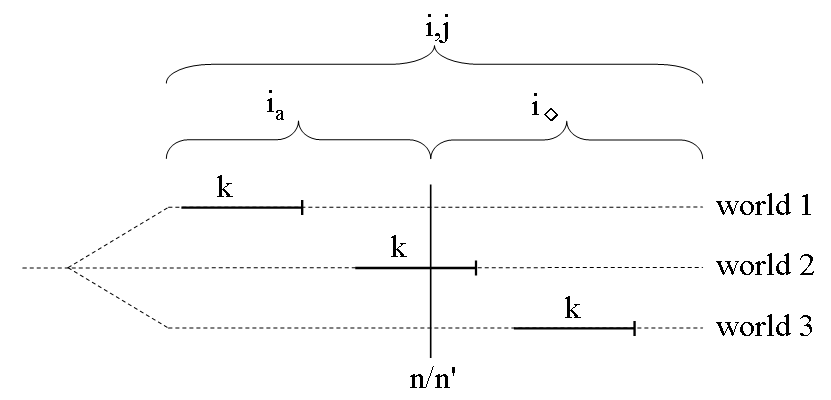
The proposal outlined above overgenerates considerably. We predict, for instance, that any simple present sentence can refer to the situation depicted in world 1 in Figure 1, whereas we would generally use a present perfect to refer to such a situation. Section 1.5.4.1 has shown that the prediction is correct in the more specific situation depicted in Figure 1 in which the speaker has a knowledge gap about the state-of-affairs in the actual world prior to speech time n (indicated by the fact that the split-off point of the possible worlds precedes n); example (111) can be used only if the speaker does not know whether Els has already finished reading.
| Els leest | vanmorgen | mijn artikel. | ||
| Els reads | this.morning | my paper | ||
| 'Els is reading my paper this morning.' | ||||
The reason for this is pragmatic in nature. If the speaker knows that eventuality k precedes n , he can present k as a discrete, bounded unit which has been completed within the actualized part time interval ia of present-tense interval i: since this can be described more precisely by the present perfect, Grice’s maxim of quantity prohibits the use of the less informative simple present. We refer the reader to 1.5.4.1, sub II, and 1.5.4.2, sub II, for a more detailed discussion.
Furthermore, it seems that simple present-tense clauses refer by default to the situation depicted in world 2 in Figure 1, while present perfect clauses refer by default to the situation depicted in world 1 in Figure 2; reference to the situations in the alternative worlds is possible but only if the context provides special clues that this is indeed what is intended by the speaker. The subsections below will show that temporal and locational adverbials play an important role in providing such clues. The discussion will pay special attention to how their status as clause or VP adverbial affects their meaning contribution, subsection II starts by discussing the temporal adverbials; it adopts the hypothesis put forth in Sections 1.5.4.1, sub III, and 1.5.4.2, sub III, that while temporal VP adverbials modify eventuality k directly, temporal clause adverbials do so indirectly by modifying the so-called present j of k , that is, the subdomain of present/past-tense interval i within which k must be located and which is taken to be identical to i in the default case (as indicated in the two figures above), subsection III will show that something similar holds for locational adverbials.
This subsection discusses the semantic contribution of the temporal adverbials to the meaning of the clause. We will adopt the standard assumption from Section 8.2.1 that VP adverbials are modifiers of the proposition expressed by the lexical projection of the verb. In terms of the tense representations in Figure 1 and Figure 2 this amounts to saying that VP adverbials are modifiers of an eventuality k. This is evidently correct for durational adverbials such as drie uur (lang)'for three hours' in (112), which simply indicate the duration of k.
| Jan heeft | drie uur (lang) | gezongen. | ||
| Jan has | three hour long | sung | ||
| 'Jan has been singing for three hours.' | ||||
This is also correct for punctual adverbials such as om 15.00 uur 'at 3 p.m.' in (113), which locates the eventuality of Jans departure at 3 p.m. in the non-actualized part i◊ of present-tense interval i (where the selection of i◊ is due to the use of the simple present for the pragmatic reason discussed in Subsection I). The default interpretation of (113a) is that Jan will be leaving at 3 o’clock today, but it can easily be overridden by contextual factors; this is especially clear in example (113b) where the clause adverbial morgen 'tomorrow' is used to indicate that the departure of Jan will take place at 3 o’clock of the first day following speech time n. Note that we have added the modal adverb waarschijnlijk 'probably' in order to distinguish between VP and clause adverbials; here we will ignore its semantic distribution in our discussion for the sake of simplicity.
| a. | Jan vertrekt | (waarschijnlijk) | om 15.00 uur. | |
| Jan leaves | probably | at 3:00 p.m. | ||
| 'Jan will (probably) leave at 3:00 p.m.' | ||||
| b. | Jan vertrekt | morgen | (waarschijnlijk) | om 15.00 uur. | |
| Jan leaves | tomorrow | probably | at 3:00 p.m. | ||
| 'Jan will (probably) leave at 3:00 p.m. tomorrow.' | |||||
The easiest way of accounting for the meaning contribution of the clause adverbial morgen'tomorrow' in (113b) is by assuming that it modifies the present j of k: representation (114) shows that j is taken to be identical to i by default, but that the use of a temporal clause adverbial restricts j to a subdomain of i; for ease of representation we indicated the non-default interpretation of j (and k) by means of a prime.
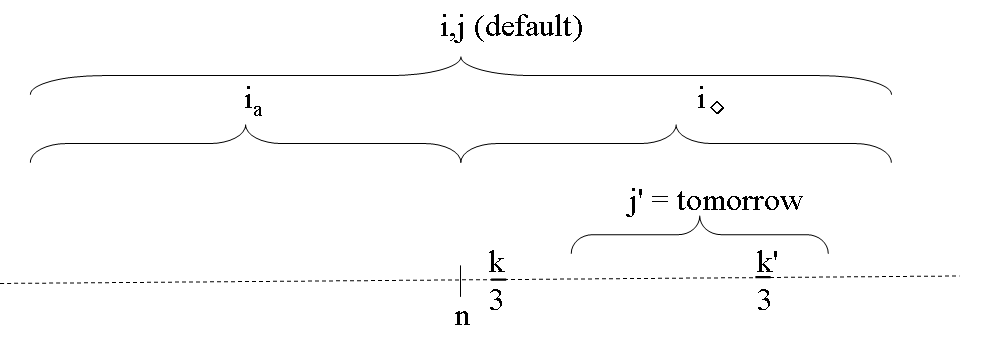 |
If we assume, as indicated in representation (114), that sentence (113a) is uttered at noon, its default interpretation would be derived as follows: the present j of k will be taken by default to be identical to the present-tense interval i. Since the simple present is again restricted to the non-actualized part i◊ of present-tense interval i for pragmatic reasons, the sentence refers to eventuality k as this is the first occasion after speech time n that fits the description om 15.00 uur (indicated by the numeral 3 in representation (114)). Note in passing that the sentence would refer to k' by default if it were uttered at 10.00 p.m., as this would be the first occasion after speech time n that fits the description om 15.00 uur . Representation (114) also shows that the default interpretation of (113a) is overridden in (113b) by the clause adverbial morgen 'tomorrow' , which restricts the present of the eventuality to time interval j': as a result, sentence (113b) can only refer to k'.
Now consider the present prefect examples in (115). If we assume that sentence (115a) is uttered in the evening, its default interpretation would be that eventuality k occurred earlier that day. The examples in (115b&c) show that this default reading can easily be overridden by adding a clause adverbial such as gisteren 'yesterday' or morgen 'tomorrow' .
| a. | Jan is | (waarschijnlijk) | om 15.00 uur | vertrokken. | |
| Jan is | probably | at 3:00 p.m. | left | ||
| 'Jan (probably) left at 3:00 p.m.' | |||||
| b. | Jan is gisteren | (waarschijnlijk) | om 15.00 uur | vertrokken. | |
| Jan is yesterday | probably | at 3:00 p.m. | left | ||
| 'Jan (probably) left at 3:00 p.m. yesterday.' | |||||
| c. | Jan is morgen | (waarschijnlijk) | om 15.00 uur | vertrokken. | |
| Jan is tomorrow | probably | at 3:00 p.m. | left | ||
| 'Jan will (probably) have left at 3:00 p.m. tomorrow.' | |||||
The easiest way to account for the meaning contribution of the clause adverbials is again by assuming that clause adverbials modify the present j of k; this is shown in representation (116), in which the various non-default interpretations of j and k are again indicated by means of primes.
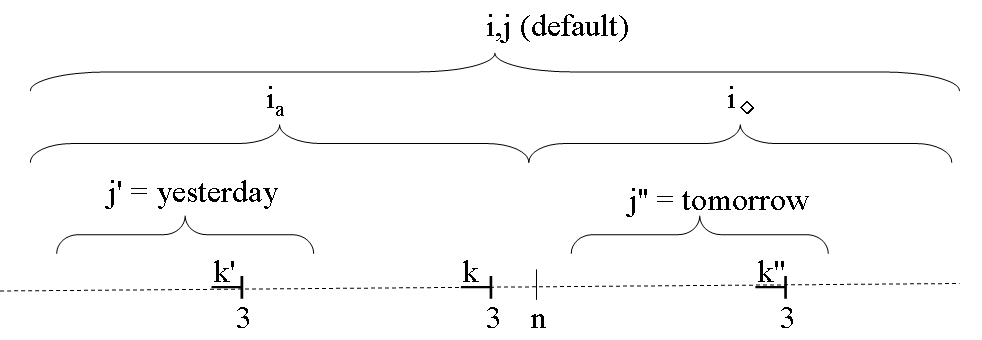 |
The default interpretation would be derived as follows. First, the present j of the eventuality will be taken to be identical to the present-tense interval i. Since Subsection I has shown that the present perfect is restricted to the actualized part ia of the present-tense interval i for pragmatic reasons, the sentence refers to eventuality k, as this is the first occasion preceding speech time n that fits the description om 15.00 uur; note in passing that the sentence would refer to k' by default, if it were uttered at 8.00 a.m., as that would then be the first occasion before speech time n that fits the description om 15.00 uur. The default interpretation of (115a) is overridden in (115b) by the clause adverbial gisteren'yesterday', which restricts the present j to the time interval j': as a result, sentence (115b) can only refer to k'. Similarly, the clause adverbial morgen'tomorrow' in (115c) overrides the default interpretation of (115a) and restricts the present j to time interval j'': as a result, sentence (115c) can only refer to k''.
Representation (116) suggests that the VP adverbial om 15.00 uur locates the completion of the eventuality at 3 p.m. precisely. However, this is not what this adverbial actually does: it instead refers to a time at which the resulting state of eventuality k applies. This is clear from examples such as (117), based on Janssen (1983), in which the adverbial al indicates that the completion of the eventuality of Jan’s departure took place before 3 p.m. From this we may conclude that the interpretations indicated in representation (116) are default interpretations of the modified structures in (115b&c), which can again be overridden by adverbial modification (here: by al).
| Jan is | (waarschijnlijk) | om 15.00 uur | al | vertrokken. | ||
| Jan is | probably | at 3:00 p.m. | already | left | ||
| 'Jan will (probably) already have left at 3:00 p.m.' | ||||||
The examples discussed so far have all been in the present tense, but the account can straightforwardly be applied to corresponding past tense cases as well (which will not be demonstrated here). We can conclude from this that the semantic interpretation of clauses with two temporal adverbials finds a natural accommodation and explanation in binary tense theory. This provides a strong argument in favor of the binary tense theory because Janssen (1983: fn.1) has shown that such cases are highly problematic for the Reichenbachian approach. Binary tense theory also accounts for the stringent word order restriction that applies to the two adverbials. First, consider the examples in (118), which show that the adverbials morgen'tomorrow' and om 15.00 uur'at 3 oʼclock' can be used freely either as a VP adverbial or as a clause adverbial.
| a. | Jan gaat | waarschijnlijk | morgen/om 15.00 uur | naar de bioscoop. | |
| Jan goes | probably | tomorrow/at 3:00 p.m. | to the cinema | ||
| 'Jan will probably go to the cinema tomorrow/at 3:00 p.m.' | |||||
| b. | Jan gaat | morgen/om 15.00 uur | waarschijnlijk | naar de bioscoop. | |
| Jan goes | tomorrow/at 3:00 p.m. | probably | to the cinema | ||
| 'Jan will probably go to the cinema tomorrow/at 3:00 p.m.' | |||||
When the two adverbials co-occur in a single clause, however, there are severe restrictions on their distribution: the examples in (119) show that morgen'tomorrow' must precede while om 15.00 uur must follow the modal adverb waarschijnlijk'probably'. Note in passing that we do not discuss cases such as Jan gaat morgen om 15.00 uur waarschijnlijk naar de bioscoop, in which the phrase Morgen om 15.00 uur constitutes a single clause adverbial, as is clear from the fact that it can be topicalized as a whole: Morgen om 15.00 uur gaat Jan waarschijnlijk naar de bioscoop.
| a. | Jan gaat | morgen | waarschijnlijk | om 15.00 uur | naar de bioscoop. | |
| Jan goes | tomorrow | probably | at 3:00 p.m. | to the cinema | ||
| 'Jan will probably go to the cinema at 3:00 p.m. tomorrow.' | ||||||
| b. | $ | Jan gaat | om 15.00 uur | waarschijnlijk | morgen | naar de bioscoop. |
| Jan goes | at 3:00 p.m. | probably | tomorrow | to the cinema |
The use of the dollar sign in (119b) indicates that the reason for the unacceptability of this example is not syntactic but semantic in nature: it is simply incoherent. Because j contains eventuality k, the modifier of j must refer to a time interval that contains the time (interval) indicated by the modifier of k. This is indeed the case in (119a), as morgen refers to a time interval that contains a point in time indicated by the adverbial om 15.00 uur, but this is not the case in (119b). For the same reason, an example such as (120) will only be felicitous if the addressee knows that there will be a meeting the next day; if not, the addressee will correct the speaker or ask him for more information about this meeting.
| Jan geeft | morgen | waarschijnlijk | een lezing | na de vergadering. | ||
| Jan gives | tomorrow | probably | a talk | after the meeting | ||
| 'Jan will probably give a talk after the meeting tomorrow.' | ||||||
It is often difficult to pinpoint the precise semantic difference between the use of an adverbial as a VP adverbial or a clause adverbial. Consider the simple present examples in (121):
| a. | Jan gaat | waarschijnlijk | zaterdag | dansen. | VP adverbial | |
| Jan goes | probably | Saturday | dance | |||
| 'Jan will probably go dancing on Saturday.' | ||||||
| b. | Jan gaat | zaterdag | waarschijnlijk | dansen. | clause adverbial | |
| Jan goes | Saturday | probably | dance | |||
| 'Jan will probably go dancing on Saturday.' | ||||||
Many speakers judge these examples to be near-synonymous as they both refer to a dancing event on Saturday, but the semantic representations assigned to them under our current assumptions are quite different. In (121a), the present j of k is simply assigned the default reading according to which it is identical to present-tense interval i; eventuality k will be located in the non-actualized part i◊ of this interval for pragmatic reasons and will therefore be situated at the first Saturday following speech time n; cf. representation (122a). The interpretation in (122b) is more indirect: first the present j of k is limited to the first Saturday in i◊ and then eventuality k is located in this restricted time interval; cf. representation (122b). Note that the continuous line below k refers to the time interval referred to by Saturday in (122a) but to the duration of k in (122b).
| a. |  |
| b. | 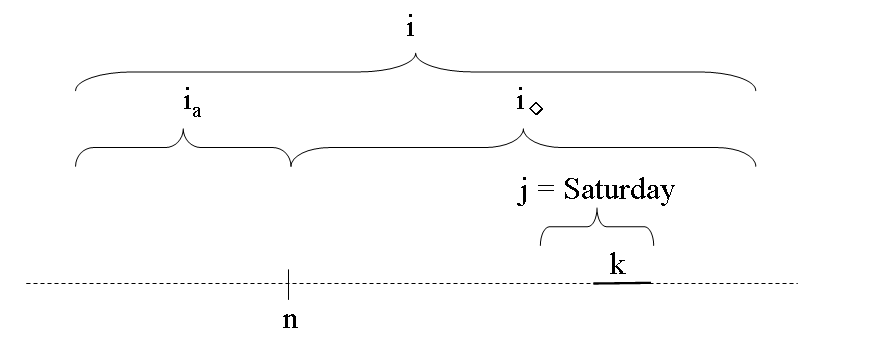 |
The meaning difference can be highlighted by means of the scope paraphrases that we have introduced for detecting clause adverbials. While (121a) can be paraphrased as Het is waarschijnlijk zo dat Jan zaterdag gaat dansen'It is probably the case that Jan will go dancing on Saturday', example (121b) can be paraphrased as Het is zaterdag waarschijnlijk zo dat Jan gaat dansen'On Saturday, it is probably the case that Jan will go dancing'. The meaning difference becomes more conspicuous in examples such as (123) with the frequency adverb altijd'always'.
| a. | Jan gaat | altijd | op zaterdag | dansen. | VP adverbial | |
| Jan goes | always | on Saturday | dance | |||
| 'Jan always goes dancing on a Saturday.' | ||||||
| b. | Jan gaat | op zaterdag | altijd | dansen. | clause adverbial | |
| Jan goes | on Saturday | always | dance | |||
| 'Jan always goes dancing on Saturdays.' | ||||||
Frequency adverbs such as altijd ‘always’ express that we are dealing with a re-occurring eventuality k in present/past-tense interval i. The VP adverbial op zaterdag'on a Saturday' in (123a) provides more precise information about the locations of k; it indicates that k takes place on Saturdays only, as in representation (124a), in which s stands for Saturday. The clause adverbial op zaterdag'on Saturdays' in (123b), on the other hand, indicates that it is an inherent property of Saturdays that k occurs; cf. (124b).
| a. |  |
| b. | 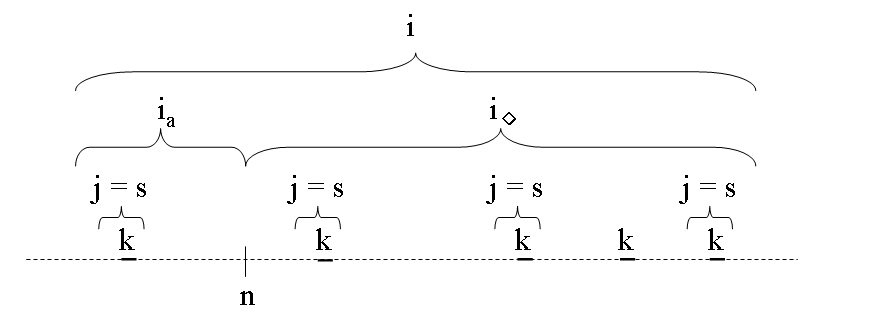 |
Representation (124a) also shows that it is not necessary that k occurs at every Saturday in order for (123a) to be true, while such a representation would make example (123b) false. Representation (124b) further shows that (123b) allows k to occur on other days as well, while such a representation would make (123a) false. This suggests that the examples in fact express material implications: example (123a) can be paraphrased by (125a), while (123b) can be paraphrased by (125b).
| a. | If Jan goes dancing, it is a Saturday. |
| b. | If/Whenever it is a Saturday, Jan goes dancing. |
This section has discussed a number of phenomena that receive a natural account within the binary tense approach. Since temporal modification in relation to tense theory is still a relatively unexplored domain, we have to leave it to future research to investigate to what extent binary tense theory can be exploited in this domain (although the reader may find some more information on this in Section 1.5.4). Subsection III will continue by showing that clauses with two locational adverbials may receive a similar account as clauses with two temporal adverbials.
This subsection discusses the semantic contribution of locational adverbials to the meaning of the clause. We again adopt the standard assumption from Section 8.2.1 that VP adverbials are modifiers of the proposition expressed by the lexical projection of the verb. In terms of tense representations like those given in Figure 1 and Figure 2, this amounts to saying that VP adverbials are modifiers of eventuality k. This claim is evidently correct for example (126a), which simply locates the eventuality of Jan staying in some hotel. It is, however, less clear what the semantic contribution of the clause adverbial in Amsterdam in (126b) is.
| a. | Jan verblijft | (waarschijnlijk) | in een hotel. | |
| Jan lodges | probably | in a hotel | ||
| 'Jan is (probably) staying in a hotel.' | ||||
| b. | Jan verblijft | in Amsterdam | (waarschijnlijk) | in een hotel. | |
| Jan lodges | in Amsterdam | probably | in a hotel | ||
| 'Jan is (probably) staying in a hotel in Amsterdam.' | |||||
Assume that the sentences in (126) are used in a conversation about Jan, who is currently on a vacation. The default reading of example (126a) would then be that the eventuality of Jan staying in a hotel occurs at speech time n, as depicted in (127): the present j of k is taken to be identical to the present-tense interval i and k is taken to co-occur with speech time n.
 |
Example (126b) would instead express that the eventuality of Jan staying in a hotel is limited to the period in which he is visiting Amsterdam. This can be accounted for by assuming that the locational clause adverbial overrides the default interpretation in the same way as a temporal clause adverbial, namely by restricting the present j of the eventuality. This is shown in representation (128), in which k is the eventuality of Jan being on holiday and k' is the eventuality of Jan staying in a hotel.
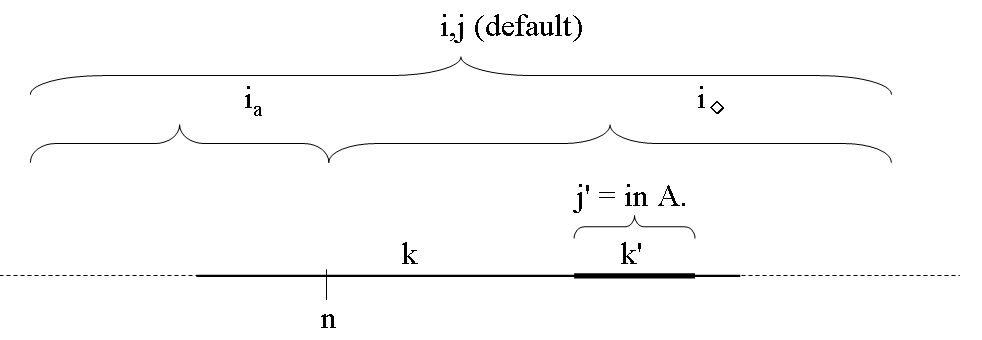 |
The discussion above has shown that locational and temporal adverbials are similar in that they modify the eventuality k when they are used as a VP adverbial, but the present j of k when they are used as clause adverbials. As in the case of temporal adverbials, the two uses of locational adverbials are not always easy to distinguish. Consider the examples in (129).
| a. | Jan gaat | waarschijnlijk | in Amsterdam dansen. | VP adverbial | |
| Jan goes | probably | in Amsterdam dance | |||
| 'Jan will probably go dancing in Amsterdam.' | |||||
| b. | Jan gaat in Amsterdam waarschijnlijk | dansen. | clause adverbial | |
| Jan goes in Amsterdam probably | dance | |||
| 'Jan will probably go dancing in Amsterdam.' | ||||
Many speakers judge these examples to be near-synonymous as they both refer to a dancing event in Amsterdam, but the semantic representations assigned to them under our current assumptions are quite different. In (129a), the present j of k is simply assigned the default reading according to which it is identical to present-tense interval i. The eventuality k will be located in the non-actualized part i◊ of this interval for pragmatic reasons; see representation (130a), which is essentially the same as (122a). The interpretation in (129b) is more indirect: first the present j of k is limited to the first occasion in i◊ that Jan will be in Amsterdam and then eventuality k is located in this restricted time interval; cf. representation (130b), which is essentially the same as (122b).
| a. |  |
| b. | 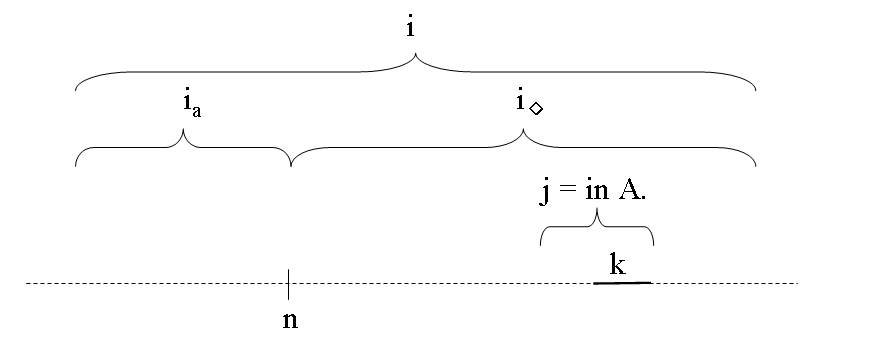 |
The meaning difference shows up in the scope paraphrases as well. While (129a) can be paraphrased as Het is waarschijnlijk zo dat Jan in Amsterdam gaat dansen'It is probably the case that Jan will go dancing in Amsterdam', example (129b) can be paraphrased as Het is in Amsterdam waarschijnlijk zo dat Jan gaat dansen'In Amsterdam, it will probably be the case that Jan will go dancing'. The meaning difference again becomes more conspicuous in examples such as (131), with the frequency adverb altijd'always'.
| a. | Jan gaat | altijd | in Amsterdam dansen. | VP adverbial | |
| Jan goes | always | in Amsterdam dance | |||
| 'Jan always goes dancing in Amsterdam.' | |||||
| b. | Jan | gaat in Amsterdam altijd | dansen. | clause adverbial | |
| Jan | goes in Amsterdam always | dance | |||
| 'Jan always goes dancing in Amsterdam.' | |||||
The frequency adverb altijd is used to express that we are dealing with a re-occurring eventuality k in the present/past-tense interval i. The VP adverbial in Amsterdam (131a) provides more precise information about the location of k; it indicates that k takes place in Amsterdam only, as in representation (132a), in which A stands for in Amsterdam. The clause adverbial in Amsterdam in (131b), on the other hand, indicates that it is an inherent property of Jan’s visits to Amsterdam that k occurs; cf. (132b).
| a. |  |
| b. | 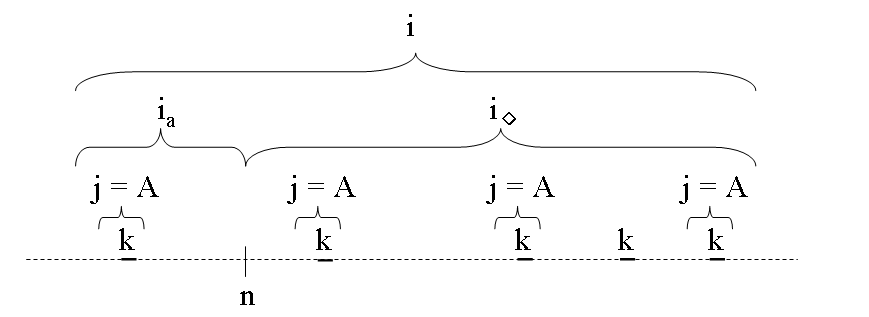 |
Representation (132a) also shows that it is not necessary that k occurs at every occasion that Jan is in Amsterdam in order for (131a) to be true, while such a representation would make example (131b) false. Representation (132b) further shows that (131b) allows k to occur on other days as well, while such a representation would make (131a) false. This suggests that the examples in fact express material implications: example (131a) can be paraphrased by (133a), while (131b) can be paraphrased by (133b).
| a. | If Jan goes dancing, he is in Amsterdam. |
| b. | If/Whenever Jan is in Amsterdam, he goes dancing. |
The discussion above has shown that locational clause adverbials have more or less the same semantic impact as temporal clausal adverbs. Locational and temporal clause adverbials may also co-occur. The examples in (134a&b) are simply repeated from above and show that op zaterdag and in Amsterdam can both be used as clause adverbials; example (134c) shows that the two can also be combined. Such examples can be paraphrased as material implications with two conditions: (P & Q) → R: “if Jan is in Amsterdam and if it is Saturday, Jan goes dancing”.
| a. | Jan gaat | op zaterdag | altijd | dansen. | |
| Jan goes | on Saturday | always | dance | ||
| 'Jan always goes dancing on Saturdays.' | |||||
| b. | Jan gaat in Amsterdam altijd | dansen. | |
| Jan goes in Amsterdam always | dance | ||
| 'Jan always goes dancing in Amsterdam.' | |||
| c. | Jan gaat | in Amsterdam | op zaterdag | altijd | dansen. | |
| Jan goes | in Amsterdam | on Saturday | always | dance | ||
| 'Jan always goes dancing in Amsterdam on Saturdays.' | ||||||
The previous subsections have shown that clauses with multiple temporal/locational adverbial phrases find a natural accommodation and explanation in binary tense theory: used as VP adverbials, they modify the eventuality expressed by the lexical domain of the clause; used as clause adverbials, they modify the present of this eventuality. We have noted that the difference between the resulting interpretations can be made more telling in the presence of the frequency adverb altijd; the interpretation can then be paraphrased by means of material implications, as illustrated by the example in (135), repeated from Subsection II.
| a. | Jan gaat | altijd | op zaterdag dansen. | VP adverbial | |
| Jan goes | always | on Saturday dance | |||
| 'Jan always goes dancing on a Saturday.' | |||||
| a'. | If Jan goes dancing, it is a Saturday. |
| b. | Jan | gaat op zaterdag altijd | dansen. | clause adverbial | |
| Jan | goes on Saturday always | dance | |||
| 'Jan will probably go dancing on Saturdays.' | |||||
| b'. | If it is a Saturday, Jan goes dancing. |
In conclusion, note that a similar effect was found in Section A6.3, sub III in the case of supplementives. This would suggest that our proposal concerning temporal and locational adverbials may be extended to other adverbials and adjuncts in general. Since this suggestion opens a new research program, we leave this issue for future research.
- 2014Binary tense and modalityNatural Language & Linguistic Theory32973-1009
- 1983Het temporele systeem van het Nederlands:drie tijden en twee tijdscompositiesGLOT645-104
- 1983Het temporele systeem van het Nederlands:drie tijden en twee tijdscompositiesGLOT645-104
- 2008Binary tensenullnullStanfordCSLI Publications
- 2008Binary tensenullnullStanfordCSLI Publications
- 2008Binary tensenullnullStanfordCSLI Publications
- 1866Over de wijzen en tijden der werkwoordenDe Taalgids866-75
